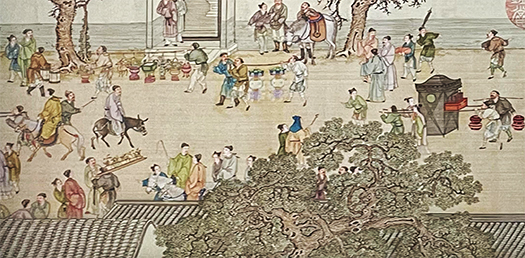


中国軍はいま台湾封鎖して周囲に実弾射撃を行い、
ペロシさんを迎えた台湾の人々に恫喝を加え続けている。
自分より弱い者へは居丈高に恫喝を加えるという
まるでマンガのジャイアンのようで非常識な「国家」姿勢。
共産党独裁の中国国家の危険性が世界全体に露わになったと言える。
そういうなかで東京国立博物館では日中国交正常化50周年で
特別デジタル展「故宮の世界」展が開かれている。
しかし通常の展示催事と比較して、会場面積規模は1/4程度。
どのような経緯でこういった小規模開催となったのか、不思議。
この故宮・紫禁城建築のVR画像展も日本の凸版印刷の技術で開催なので
どのような芸術面での外交経緯だったのか、興味深い。
いまのところ、このあたりの情報は出てきていないのですが今後注視したい。
で、東京国立博物館はこのデジタルVR展だけではさすがにまずいと考えて
同時開催として「清朝宮廷の書画と工芸」と銘打って東京国立博物館が
所蔵・管理する清朝宮廷美術作品(これは実物)も展示していた。
日本絵画や西洋絵画については国内で目に触れる機会も多く、また、
日本国内での収蔵作品もたいへん多様で多いのですが
一方で中国絵画については日本ではあまり接する機会がない。
今回は展示自体が非常にさみしいものだったからか、
写真撮影については全許諾されていたので、たっぷり撮影させていただいた。
そのなかでも中国・清の時代に描かれた「慶豊図巻」が素晴らしかった。
画材テーマは1740年当時の都・北京の正月の市街のにぎわいぶり。
伝統的な独裁国家らしく皇帝・乾隆帝治政が素晴らしいので民も豊かである
といういやらしい「工作」的意図があけすけに語られている。
別に美術鑑賞としては支配者の見栄は耳にしたくはない(笑)。
「慶豊図巻」には5メートル以上、華やかな都市北京の賑やかさが緻密に描かれる。
前文に清朝重臣
の書家・梁詩正が乾隆帝自作の詩を書いている。
(3枚目の写真参照ください。)
ここに満月を寿ぐ句や「皇都」の言葉が見られる。
以上のことからこの長巻には、
元宵節(旧暦1月15日の祭)を迎えた北京が描かれているとわかる。
テーマ的には日本の「洛中洛外図」と同様のものでしょう。
日本の場合は襖絵として描かれるけれど、中国では長大な巻物表現。
洛中洛外図では賀茂川に掛かる橋や名所などが描かれて
建築と人間模様風俗が表現される。名所などの特定はわからないけれど、
この「慶豊図巻」でも制作意図はこれと同様のようです。
門構えや四合院的な建築周囲の塀囲い、建築外観が面白い。
また道路も非常に幅広な大路が舞台として表現されている。
移動手段として大小の馬高の馬が描かれているけれど、小さい方は馬ではなく、
違う動物種のようにも思われる。ほぼ人間程度の大きさの動物か。
中国版・洛中洛外図から、時代の空気感も読んでみたい。
English version⬇
Qing Dynasty painting “Qingfeng Scroll,” City of Beijing in the 1740s.
A Qing Dynasty version of the painting “Scenes in and around the City of Beijing”. The architecture and districts, as well as the general “customs” of the people who lived in the era, overflow onto the screen. A trip through time and space. The work is a short trip through time and space.
The Chinese military is now blockading Taiwan, firing live ammunition into the surrounding area and continuing to intimidate the Taiwanese people who greeted Pelosi.
The Chinese military is now blockading Taiwan, firing live ammunition around the island, and continuing to intimidate the Taiwanese people who welcomed Pelosi.
It is an insane “national” posture that stoutly adds argument to those who are weaker than oneself.
It is an insane “national” posture like Gian of the cartoon.
It can be said that the danger of the Chinese nation of the communist dictatorship was exposed to the whole world.
In such a situation, the Tokyo National Museum is holding a special digital exhibition
The special digital exhibition “The World of NPM” is currently being held at the Tokyo National Museum.
Compared to a normal exhibition, however, the size of the exhibition space is only about 1/4 of that of a regular exhibition.
One wonders how it came to be held on such a small scale.
The exhibition of VR images of the Palace Museum and the Forbidden City was also held using Japanese letterpress printing technology, so I wonder what kind of artistic diplomacy was involved.
It would be interesting to know how the artistic diplomacy was conducted.
So far, no information has emerged in this area, but we will keep a close eye on it in the future.
The Tokyo National Museum has decided that this digital VR exhibition alone is not good enough.
The Tokyo National Museum, however, thought it would be a bad idea to hold a concurrent exhibition titled “Calligraphy, Painting, and Crafts of the Qing Dynasty Court.
The museum also exhibited actual works of art from the Qing court that are in the Tokyo National Museum’s collection and under its management.
There are many opportunities to see Japanese and Western paintings in Japan.
Japanese and Western paintings are often seen in Japan, and the collection in Japan is very diverse and large.
On the other hand, there are few opportunities to come into contact with Chinese paintings in Japan.
Perhaps it was because the exhibition itself was very lonely.
I was allowed to take plenty of photographs, as I had full permission to do so.
Among them, the “Qing Feng Scroll” painted in the Qing Dynasty of China was wonderful.
The theme of the painting was the bustling city of Beijing during the New Year in 1760.
The people were prosperous because of the emperor Qianlong’s rule, as in a traditional dictatorship.
The work is openly intended to be a disgusting “manipulation” of the people’s wealth.
As an art appreciator, I do not want to listen to the pretensions of the rulers (laugh).
The “Qingfeng Scroll” is more than 5 meters long, and depicts the bustle of the gorgeous city of Beijing in great detail.
The preamble is a poem by Liang Shi-zheng, a calligrapher and senior official of the Qing Dynasty, written by the Ch’ien-lung Emperor himself.
(See the third photo.) Here is a poem that celebrates the full moon.
(See the third photo.) Here we can see phrases celebrating the full moon and the words “the imperial capital.
Based on the above, this long scroll is dated to the
The theme of this long scroll is the Japanese “Lantern Festival” in Luochu.
Thematically, it is probably similar to the “Rakuchu Rakugai-zu” in Japan.
In Japan, it is depicted as a sliding door painting, but in China, it is a long scroll representation.
In Rakuchu-Rakugai-zu, bridges over the Kamo River and famous places of interest are depicted.
The Raku-chu-Rakugai-zu depicts architecture, human figures, and customs. Although we do not know the specifics of the places of interest
but it seems that the intent of this “Keiho” scroll is the same as this one.
The gate, the fence around the building in the style of a shikai-in (a traditional Japanese-style house), and the exterior appearance of the building are interesting.
The roads are also represented as a stage with very wide avenues.
Although horses of various sizes and heights are depicted as means of transportation, the smaller ones do not appear to be horses at all.
The smaller one is not a horse, but seems to be a different animal species. The smaller one is not a horse at all, but seems to be a different animal species.
I would like to read the atmosphere of the period from the Chinese version of Rakuchu-Rakugaizu.
Posted on 8月 7th, 2022 by 三木 奎吾
Filed under: 「都市の快適」研究, 歴史探訪







コメントを投稿
「※誹謗中傷や、悪意のある書き込み、営利目的などのコメントを防ぐために、投稿された全てのコメントは一時的に保留されますのでご了承ください。」
You must be logged in to post a comment.